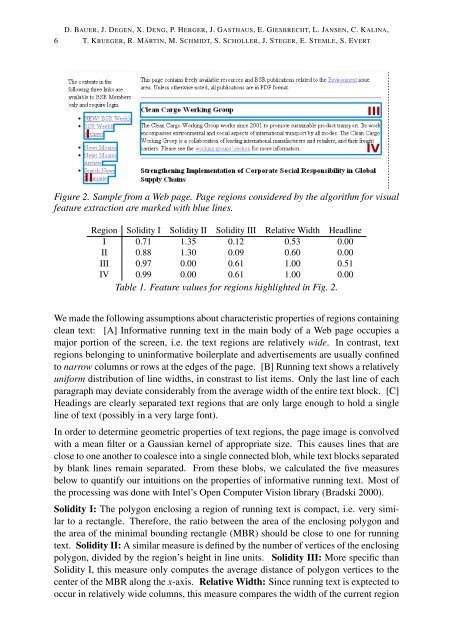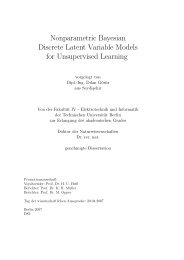FIASCO: Filtering the Internet by Automatic Subtree Classification ...
FIASCO: Filtering the Internet by Automatic Subtree Classification ...
FIASCO: Filtering the Internet by Automatic Subtree Classification ...
You also want an ePaper? Increase the reach of your titles
YUMPU automatically turns print PDFs into web optimized ePapers that Google loves.
6<br />
D. BAUER, J. DEGEN, X. DENG, P. HERGER, J. GASTHAUS, E. GIESBRECHT, L. JANSEN, C. KALINA,<br />
T. KRUEGER, R. MÄRTIN, M. SCHMIDT, S. SCHOLLER, J. STEGER, E. STEMLE, S. EVERT<br />
Figure 2. Sample from a Web page. Page regions considered <strong>by</strong> <strong>the</strong> algorithm for visual<br />
feature extraction are marked with blue lines.<br />
Region Solidity I Solidity II Solidity III Relative Width Headline<br />
I 0.71 1.35 0.12 0.53 0.00<br />
II 0.88 1.30 0.09 0.60 0.00<br />
III 0.97 0.00 0.61 1.00 0.51<br />
IV 0.99 0.00 0.61 1.00 0.00<br />
Table 1. Feature values for regions highlighted in Fig. 2.<br />
We made <strong>the</strong> following assumptions about characteristic properties of regions containing<br />
clean text: [A] Informative running text in <strong>the</strong> main body of a Web page occupies a<br />
major portion of <strong>the</strong> screen, i.e. <strong>the</strong> text regions are relatively wide. In contrast, text<br />
regions belonging to uninformative boilerplate and advertisements are usually confined<br />
to narrow columns or rows at <strong>the</strong> edges of <strong>the</strong> page. [B] Running text shows a relatively<br />
uniform distribution of line widths, in constrast to list items. Only <strong>the</strong> last line of each<br />
paragraph may deviate considerably from <strong>the</strong> average width of <strong>the</strong> entire text block. [C]<br />
Headings are clearly separated text regions that are only large enough to hold a single<br />
line of text (possibly in a very large font).<br />
In order to determine geometric properties of text regions, <strong>the</strong> page image is convolved<br />
with a mean filter or a Gaussian kernel of appropriate size. This causes lines that are<br />
close to one ano<strong>the</strong>r to coalesce into a single connected blob, while text blocks separated<br />
<strong>by</strong> blank lines remain separated. From <strong>the</strong>se blobs, we calculated <strong>the</strong> five measures<br />
below to quantify our intuitions on <strong>the</strong> properties of informative running text. Most of<br />
<strong>the</strong> processing was done with Intel’s Open Computer Vision library (Bradski 2000).<br />
Solidity I: The polygon enclosing a region of running text is compact, i.e. very similar<br />
to a rectangle. Therefore, <strong>the</strong> ratio between <strong>the</strong> area of <strong>the</strong> enclosing polygon and<br />
<strong>the</strong> area of <strong>the</strong> minimal bounding rectangle (MBR) should be close to one for running<br />
text. Solidity II: A similar measure is defined <strong>by</strong> <strong>the</strong> number of vertices of <strong>the</strong> enclosing<br />
polygon, divided <strong>by</strong> <strong>the</strong> region’s height in line units. Solidity III: More specific than<br />
Solidity I, this measure only computes <strong>the</strong> average distance of polygon vertices to <strong>the</strong><br />
center of <strong>the</strong> MBR along <strong>the</strong> x-axis. Relative Width: Since running text is exptected to<br />
occur in relatively wide columns, this measure compares <strong>the</strong> width of <strong>the</strong> current region

















